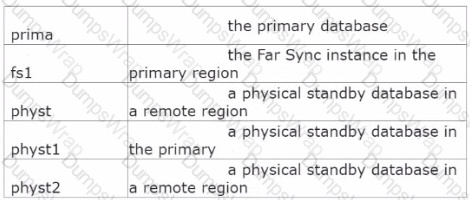Oracle Database 19c: Data Guard Administration Questions and Answers
Which two statements are true when using non-rolling release upgrades in a Data Guard environment?
Which three are prerequisites for enabling Fast-Start Failover?
Which two are prerequisites for configuring flashback database for Oracle 19c databases, in a Data Guard environment?
Which four statements are true regarding SQL Apply filters for a logical standby database?
Your Data Guard environment has two remote physical standby databases.
Client applications use the local naming method to connect to the primary database instance.
You want applications to automatically connect to the new primary database instance in case of a switchover or a failover.
Which set of actions will fulfill this requirement?
There are currently 6 applief. and 6 pfepafef processes running and no idle applier processes on y logical standby database.
The max_SERVERS SQL apply parameter and number of archiver processes are both set to 12.
Identify two changes, each of which would allow you to increase the number of applier processes.
You are licensed to use Oracle Active Data Guard.
Which TWO statements are true after enabling block change tracking on a physical standby database?
Which THREE statements are TRUE about the supported workload in Active Data Guard standby databases?
Your Data Guard environment consists of these components and settings:
1. A primary database
2. Two remote physical standby databases
3. The redo transport mode is set to sync
4. Real-time query is enabled for both standby databases
5. The DB_BLOCK_CHECKING parameter is set to TRUE on both standby databases
You notice an increase in redo apply lag time on both standby databases.
Which two would you recommend to reduce the redo apply lag on the standby databases?
You must configure an Oracle Data……….
1. A primary database
2. A physical standby database
Examine these requirements: 1. Data loss is not permitted.
1. Data loss is not permitted.
2. It should be possible to convert the physical standby database to a snapshot standby database.
3. Under normal operations, transactions should commit when redo is written to disk on the primary database and as soon as it has been received by the standby database instance.
4. The availability of the primary database should not be compromised by the availability of the standby database.
5. It should be possible to convert the physical standby database to a logical standby database
6. It should be possible to deploy Real Application Clusters on the primary database.
7. It should be possible to deploy Real Application Clusters on the physical standby database.
You configure SYNC redo transport mode in combination with Maximum Protection mode.
Which THREE statements are true about snapshot standby databases?
You must configure on Oracle Data .......
1. A primary database
2. Three Physical Standby Databases
Examine these requirements:
A designated physical standby database should become the primary database automatically whenever the primary database fails.
2. The chosen protection mode should provide the highest level of protection possible without violating the other requirement.
Which redo transport mode and protection mode would you configure to meet these requirements?
On your logical standby database, you specified these rules:

After completion of the weekend batch cycle you attempt to delete the SQL Apply filters:

Which is TRUE regarding the execution of the UNSKIP procedure?
The Oracle database 19c Observer is currently running on host1 and you wish to have it running on host2.
Examine this list of possible steps:
1) Stop the observer on host1
2) Disable Fast-Start Failover
3) Update the broker configuration with the new observer hostname
4) Enable Fast-Start Failover
5) Start the Observer on host2
Which contains the minimum required steps to move the observer to host2?
A customer has these requirements for their proposed Data Guard implementation:
1. Zero data loss must still be guaranteed through the loss of any one configuration component.
2. The primary database must be protected against a regional disaster.
3. Performance overheads on the primary should be minimized as much as possible given these requirements.
4. Downtime on the primary database for any reason must be kept to a minimum.
Components referred to in the broker commands are:

A)

B)

C)

D)

You notice that the SQL apply lag on your logical standby database has increased but the redo transport lag has not.
Which four could be reasons for the increase in SQL apply lag?
Which THREE are among the various tasks performed by the Data Guard Monitor (DMON) process?
Examine the Data Guard configuration: DGMGRL> show configuration;
Configuration - Animals
Protection Mode: MaxPerformance
Databases:
dogs- Primary database
sheep - Physical standby database
cats- Snapshot standby database
Fast-Start Failover: DISABLED
Configuration Status: SUCCESS
You receive an error while attempting to raise the protection mode to Maximum Protection:
DGMGRL> edit configuration set protection mode as maxprotection;
Error: ORA-16627: operation disallowed since no standby databases would remain to support protection
mode
Failed.
What can you conclude based on this error?
Which three statements are true……. With no Oracle Streams or Goldengate configured?
Which THREE statements are true about Far Sync instances?
Which THREE steps are prerequisites for the creation of a physical standby database on a separate server using the RMAN active database duplication method?

